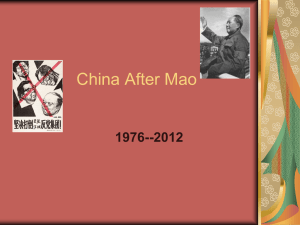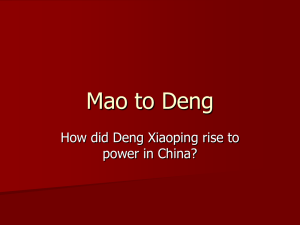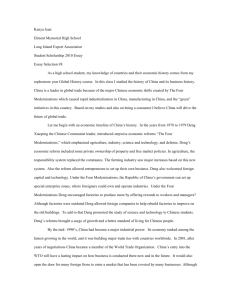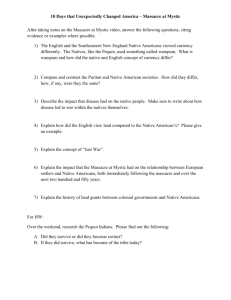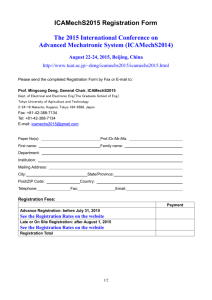Why was there a massacre in Tiananmen Square?
advertisement
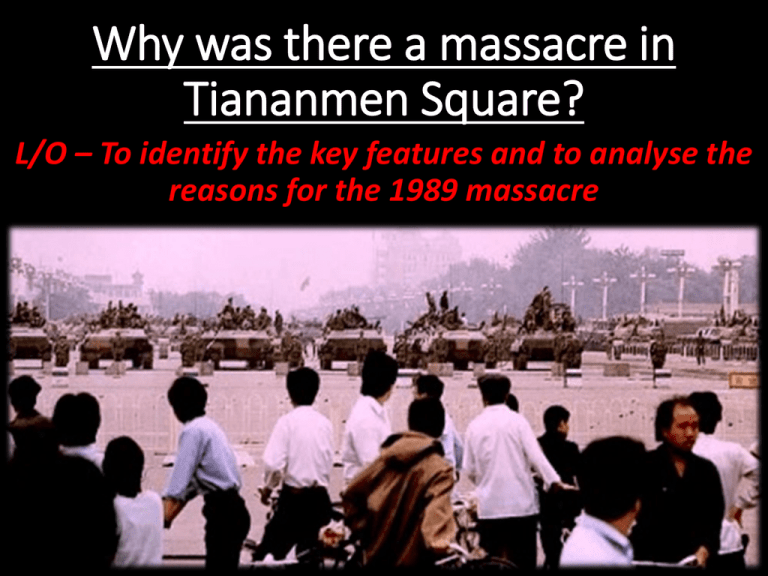
Why was there a massacre in Tiananmen Square? L/O – To identify the key features and to analyse the reasons for the 1989 massacre Key Figures Li Peng – Premier of PRC Hu Yaobang- 6th General Secretary of Communist Party Deng Xiaoping Chairman of the CCP Zhao Ziyang – 7th General Secretary of Communist Party Yang Shangkun – President of PRC The Tiananmen Square Massacre • The massacre was the climax to the tensions that had been building up in the previous ten years which, in turn, were a reaction to the failure of Deng’s reforms. • Deng had failed to address the problems caused by his modernisations and his toleration of some criticisms had even raised expectations of political change. • But the question is, why did Deng decide to use force to stop the political protests? Was he to blame for the massacre? April 1989 – The Death of Hu Yaobang • Hu Yaobang died on 15th April. Hu Hu been was remembered had sympathetic to for the his democracy movement but had liberal political opinions. He been removed in January 1987 for was one of the first Chinese supporting student protests. officials to abandon Mao suits of Western business • in Hufavour supported Deng’s reforms but Party Elders, opposed suits. to reforms, blamed him for the protests. When asked which of Mao • He had been treated harshly and Zedong’s theories died from a heart attack.were Large crowds gathered in Tiananmen desirable for modern China, Square for his memorial service. he replied, “I think, none”. April 1989 – The Death of Hu Yaobang • 3 Students tried to give a petition to the Premier Li Peng, but Li refused to accept the petition which sparked off a series of sit-ins and boycotts of university classes. • Students from 40 universities joined their fellow students in Tiananmen Square. Over 100,000 students. • Transport workers showed their support by allowing the students to travel free to Beijing. May 1989 – Hunger Strike • By the second week of May, a group of 300 students had gone on hunger strike. • The government made contact urging them to call it off. They refused because: 1. They were achieving world wide publicity with camera crews and journalists from every continent reporting events. 2. Gorbachev was due to visit Beijing. He was very popular because of his reforms in the Soviet Union. Students were convinced that the authorities would not dare crush the demonstrations during his visit. May 19th 1989 – Zhao Ziyang • On the 6th day of the hunger strike, Zhao Ziyang asked the students to end the hunger strike. In tears, he promised that the issues over which they were protesting would be resolved. • That same evening Zhao was dismissed from his post. Deng had decided that the demonstrations would be ended by force and introduced martial law. • However, then the students voted to end the hunger strike but continue the protests. May 1989 – Further Support • When news broke of the decision to continue, thousands who had earlier given up, returned to the Square. • This included many residents of Beijing who blocked the roads and avenues leading to Tiananmen Square to prevent the troops from imposing martial law. • The troops were withdrawn to the outskirts of Beijing. Early June 1989 – Troops move in • Deng was now more determined than ever to end the protests. Crack troops, led by specially appointed commanders, advanced on Beijing. • By 2nd June, 350,000 PLA soldiers surrounded Tiananmen Square and controlled the routes leading to it, ignoring the protests of the local people. Deng initially tolerated free speech in the early 1980s. Why do you think he was determined to now use force against the protesters? 3/4th June 1989 – The Massacre • The PLA commanders described the action as a ‘full military campaign’ to overcome the resistance of ‘rebels’ and recapture the Square. The troops were told to reclaim the Square at all costs. • At 10pm on the night of the 3rd June, shots were fired at protesters. By midday on the 4th, the occupation was over. • Students were marched away and imprisoned. • Unknown number of casualties • The government imposed a news blackout but information about the massacre leaked out. Why was the massacre carried out? • Deng could have used riot police, water cannons and tear gas to disperse the protesters. • The students were unarmed and not fully united and determined. However, Deng seems to have wanted a violent end to the protest. • The massacre was in the Chinese tradition of crushing opposition by the severest means in order to act as a deterrent as well as highlighting that this opposition was illegitimate. Why was the massacre carried out? • The use of tanks and bullets was to show the Chinese people the determination of the government not to tolerate opposition. • There are other explanations for the severity of Deng’s actions: 1. The Chinese government insisted the students had foreign support and were trying to undo the communist revolution. 2. Deng saw the student movement as a genuine threat to his leadership. 3. Power struggle to replace Deng between Zhao Ziyang and Li Peng. Li Peng encouraged force against the students, hoping to gain Deng’s support. Results of the Massacre • Demonstrators were rounded up and imprisoned. • CCP officials who had supported the Democracy Movement were dismissed. Zhao Ziyang was imprisoned for 15 years and died in 2005. He remains censored in China. Details of Hu Yaobang was censored until 2005. • Those who opposed demonstrations were promoted. Li Peng remained a powerful politician. Jiang Zemin replaced Zhao Ziyang as General Secretary. Results of the Massacre • The massacre and promotion of economic conservatives like Li Peng meant that economic change was slowed and market reforms delayed until 1992. • Chinese authorities announced that 23 students had been ‘accidentally’ killed. In your opinion, what was the most significant • The demonstration marked the end of outcome of the the Democracy Movement. At the 14th Party Congress of the CCP, held in Tiananmen October 1992, the dictatorship of the CCP Square was confirmed. massacre?

